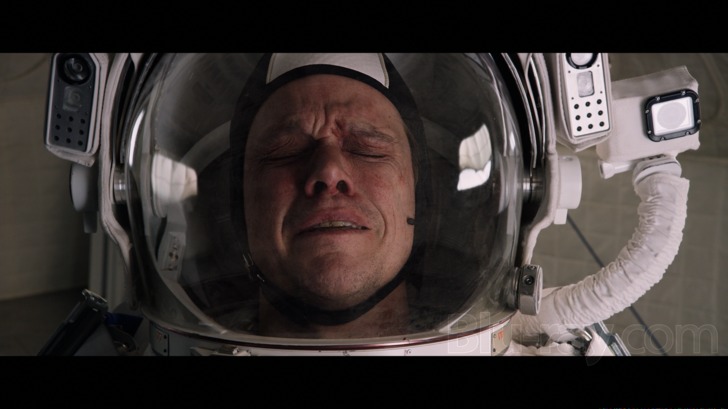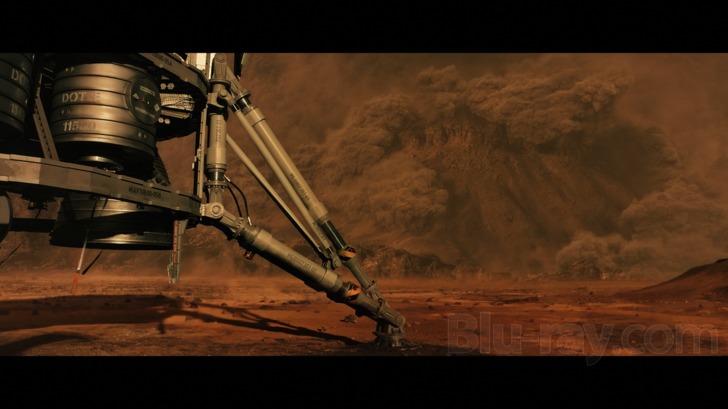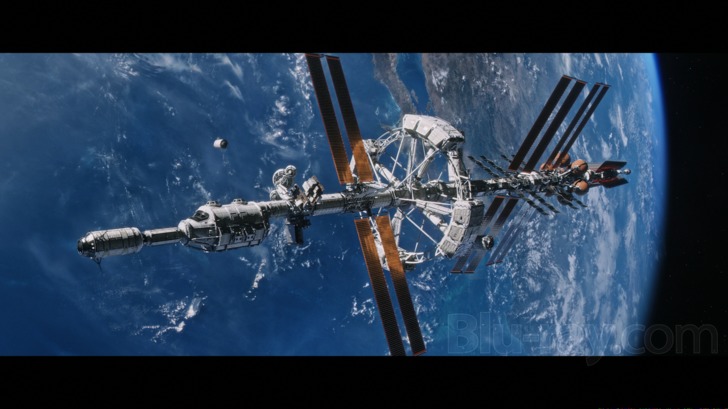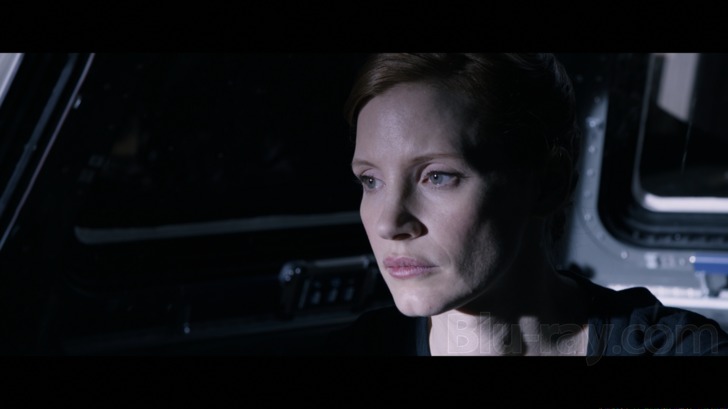The Martian 3D Blu-ray Movie
HomeThe Martian 3D Blu-ray Movie 
Blu-ray 3D + Blu-ray + UV Digital Copy20th Century Fox | 2015 | 142 min | Rated PG-13 | Jan 12, 2016

Movie rating
8.1 | / 10 |
Blu-ray rating
| Users | 4.6 | |
| Reviewer | 4.5 | |
| Overall | 4.5 |
Overview
The Martian 3D (2015)
An astronaut, left behind, uses his experience and knowledge to continue his existence on an alien planet in the hopes that one day he will be rescued.
Starring: Matt Damon, Jessica Chastain, Kristen Wiig, Jeff Daniels, Michael PeñaDirector: Ridley Scott
| Adventure | 100% |
| Sci-Fi | 81% |
| Drama | Insignificant |
Specifications
Video
Video codec: MPEG-4 MVC
Video resolution: 1080p
Aspect ratio: 2.40:1
Original aspect ratio: 2.39:1
Audio
English: DTS-HD Master Audio 7.1 (48kHz, 24-bit)
Spanish: DTS 5.1
Spanish: Dolby Digital 5.1 (448 kbps)
French: Dolby Digital 5.1 (448 kbps)
Portuguese: Dolby Digital 5.1
Portuguese Track is also 448 kbps.
Subtitles
English SDH, French, Portuguese, Spanish, Danish, Finnish, Mandarin (Simplified), Norwegian, Swedish
Discs
50GB Blu-ray Disc
Two-disc set (2 BDs)
UV digital copy
Blu-ray 3D
Packaging
Slipcover in original pressing
Playback
Region free
Review
Rating summary
| Movie | 4.5 | |
| Video | 4.5 | |
| Audio | 5.0 | |
| Extras | 2.5 | |
| Overall | 4.5 |
The Martian 3D Blu-ray Movie Review
Is there 'Gravity' on Mars?
Reviewed by Jeffrey Kauffman January 9, 2016Andy Weir deserves congratulations for any number of issues surrounding his debut novel The Martian, including having not just the cojones to self-publish but the courage to offer up a work that eschewed a number of science fiction tropes to deliver a reasonably accurate accounting of what being stranded on a “neighboring” planet might actually be like. But perhaps the most laudable thing that Weir was able to accomplish with The Martian was making science really and truly cool for a coterie of readers from all generations and different walks of life. There’s a humorous little moment in Ridley Scott’s film adapation of The Martian where stranded astronaut and botanist Mark Watney (Matt Damon) is reviewing the challenges he’s facing while trying to survive until a rescue operation—one which Watney knows will take years to realize—can be mounted. Watney resiliently states his solution to his troubles in one of his video journal entries, calmly saying, “I’m going to have to science the s*** out of this,” a statement that some readers might want to apply to Weir’s own approach toward his novel. Taking my own family as just one example in an obviously non-scientific survey, Weir’s book completely captured the fancy of both my 19 year old computer programming, coding wizard son, as well as my somewhat less tech savvy wife (whose age will not be disclosed due to my wish to remain living). It’s perhaps worth comparing The Martian’s relatively rigorous scientific anchoring to another film that dealt with a castaway on the Red Planet, Byron Haskin’s 1964 opus Robinson Crusoe on Mars. While the earlier film shares The Martian’s almost hallucinatory setting of auburn tinged cliffs and dusty dunes (Robinson Crusoe on Mars filmed its exteriors in Death Valley, while The Martian opted for some more distant locales, including Jordan), Haskin’s opus has a number of fanciful elements, including an astronaut who learns to “breathe” (with a little help) Mars’ atmosphere. This space explorer also ultimately discovers that Mars’ supposedly barren environment actually produces foodstuffs of a sort. Neither of these scientifically questionable issues are part of The Martian’s plot mechanics, and instead the film traffics in the same sort of loneliness that informed Robinson Crusoe on Mars, albeit within a context that relies on a more cogent understanding of what life on the Red Planet might actually be like. Weir’s novel was able to devote considerable narrative time to various scientific aspects which are presented more tangentially in the film version, but there’s still a feeling of veracity providing a formidable foundation to much of The Martian. Some may find the film oddly comical some of the time (there has been some blowback that it has been nominated in the comedy category of the Golden Globes), but The Martian is a slam bang entertainment that not only makes science cool, but (perhaps more importantly) absolutely riveting most of the time.

Watney is part of a team of astronauts on a mission named Ares III which has deposited a crew on the surface of Mars for a series of experiments and reconnaissance planned to take place over about a month’s time. There’s an immediate display of the camaraderie and bantering quality between these adventurers as the film starts, but things become deadly serious almost instantly when a violent storm descends, one that’s vicious enough to potentially knock over the spacecraft the team is supposed to leave the planet’s surface on. That forces an emergency evacuation order on the part of the mission’s commander, Melissa Lewis (Jessica Chastain). In a horrifying sequence the astronauts attempt to get from their “habitation” unit to the spacecraft in order to depart Mars, a short but perilous journey that ends in apparent tragedy when Watney is whacked full on by a satellite dish cartwheeling through the ferocious Martian wind. With no life sign data emanating from Watney’s spacesuit, and no ability to find Watney’s now far flung body in the pitch black darkness, Lewis has no choice but to depart with her surviving crew, supposedly leaving Watney’s corpse on the surface of Mars.
Of course Watney is not dead, and in a second horrifying sequence startles awake to the realization that he has been “speared” by part of the wiring of the satellite dish, forcing Watney to operate on himself once he drags himself back to the habitation unit. In the first of several elisions that cover huge narrative swaths contained in Weir’s book, Watney assesses his chances, taking an inventory of supplies (especially food stuffs), and decides that “sciencing” the you-know-what out of the situation is his only recourse. As a botanist, he’s aware the food will not grow in the bacteria free soil of the Red Planet, and so he sets about “injecting” that element courtesy of the human waste that has accrued in a portal of the habitation unit. He manages to grow a rather amazing crop of potatoes, something that will at least provide sufficient calories for the time being (the film tends to avoid some of the novel’s explanations, namely that Watney has vitamins to spare for those kinds of nutritional needs and is simply searching for easy calories to burn).
Meanwhile, in some kind of interruptive interstitials, a number of people back at NASA, including director Teddy Sanders (Jeff Daniels) and Mars mission director Vincent Kapoor (Chiwetel Ejiofor), become aware that Watney may well be alive and stranded, courtesy of some satellite imagery which reveals various movements on the planet. In another elision, The Martian rather perfunctorily establishes contact between the two planets, as NASA media director Annie Montrose (a not particularly well cast Kristen Wiig) attempts to manage the flow of information out to the public, since NASA first announced Watney’s death and then is forced to admit he’s alive and stranded on Mars, with the rest of the Ares III crew already well on their way back home to Earth.
Drew Goddard’s adaptive screenplay commendably keeps momentum surging forward even as a number of sidebars threaten to derail the narrative trajectory. NASA’s desperate attempts to get a rescue plan hatched encounter a number of obstacles, while Mark himself has a number of hurdles to overcome, including one potentially debilitating tragedy that unfolds (again without the helpful contextual explanation the novel provides). The story probably indulges in a bit too much espionage like subterfuge with regard to a supposedly mad rescue gambit developed by a Jet Propulsion Laboratory worker (Donald Glover) which is then appropriated against official NASA wishes by Ares III mission director Mitch Henderson (Sean Bean).
The Martian also perhaps relies on a bit too many Gravity -esque plot mechanics as the rescue attempt moves into its endgame, especially since at least some of the hyperoblic developments are creations of the film version. What works surprisingly well in this adaptation is the rather freewheeling humor that’s often on display, something that in some cases is attributable to the macho bravado of Watney, but which also tends to unfold as Mark and his Ares III crewmates get back in touch with each other. Less felicitous comedy is had courtesy of some of the NASA scenes, where Wiig’s mugging is sometimes shoehorned into the proceedings. One way or the other, this is a resolutely different tone than that which typically informs these grandiose science fiction epics, and may seem at least intermittently odd to some viewers.
Damon does exceptional work here, in what amounts to a solo performance for long if not exclusive swaths of the film. The probably overstuffed supporting cast often doesn’t have a whale of a lot to work with, but most performers manage to create quickly accessible and relatively believable characters. The film version eschews much in the way of backstory, though, simply offering many of the large array of supporting personnel as types or even plot conveniences utilized to move things along. Director Ridley Scott is certainly no stranger to larger than life cinematic exploits, and he marshals his forces here extremely well, delivering a well paced and exciting adventure despite the film’s well over two hour running time.
The Martian 3D Blu-ray Movie, Video Quality 

The Martian is presented on Blu-ray with both an AVC (2D) and MVC (3D) encoded 1080p transfer in 2.40:1 (on separate Blu-ray discs).
Shot digitally with a variety of (mostly Red) cameras, The Martian benefits from some eye catching panoramas of the (supposed)
Martian
landscape, views that often offer fantastic depth of field and excellent precision on elements like fine, red sand particles (and particulates
floating
through the air). Scott and frequent Scott collaborator cinematographer Dariusz Wolski have indulged in some fairly rote color grading
schemes
that frequently cast NASA scenes (as well as several scenes on the Ares III return flight) in shades of cool blues or slate grays, and (more
understandably) Mars sequences in a buttery, orange-
yellow
color. Despite these gambits, detail is still commendably evident, though some of the NASA scenes suffer from a lack of significant fine detail in
midrange shots and occasionally also offer less than fulsome shadow detail. The film's use of a video journal in place of narrative elements in
the
novel is stylistically separated from the bulk of the film with both data overlays and a softer, grittier appearance (see screenshots 8 and 16).
Fine
detail is often superb in close-ups, where smaller details like droplets of water adorning the walls of Watney's makeshift greenhouse are
presented with precision. Also commendably sharp and well detailed is the bulk of the film's CGI, with no elements sticking out as overly
artificial
looking. Contrast is consistent and black levels excellently deep, helping to make some of the outer space sequences, notably the adrenaline
pumping finale, pop extremely well. There were no problematic compression anomalies on display and no instances of image instability were
noticed.
The Martian's 3D presentation is similarly impressive, though it rarely engages in the kind of (literal) "in your face" constructions that
informed Gravity at times. In fact one of the 3D presentation's central accomplishments is how much depth it offers even in some of
the darkest sequences, notably the horrifying storm that starts the film, where commendable dimensionality is achieved with little other than
zinging bits of Martian dirt and debris zooming through the foreground. While much of the rest of the presentation doesn't offer this sort of
complexity or "wow" factor, there's still considerable depth of field in the many exterior shots, where Scott will routinely place a piece of a
foreground object in order to immediately establish distance relationships within the frame. Perhaps ironically, one of the places where there
isn't much depth is in shots of the starry beyond, which often look fairly flat when compared to the bulk of this presentation. Less ostentatious
but still quite effective is the layering of spatial information on the video journal entries, where the data overlays are clearly placed in front of
Watney's confessionals.
The Martian 3D Blu-ray Movie, Audio Quality 

The Martian's lossless DTS-HD Master Audio 7.1 track is predictably a veritable riot of surround activity in bigger moments like the opening
storm, where whip pan effects zing around and through the surround channels with abandon, or, later, during the extended rescue sequence,
where everything from rocket engines blasting to smaller emissions of compressed air offer excellent opportunity for discrete channelization and
LFE support. Dynamic range is hugely wide throughout this presentation, offering everything from cataclysmic explosions to almost sonically
barren moments with Watney out on the Martian plains. Other elements, like Watney's video journal entries or even traditional dialogue scenes,
are more traditionally anchored front and center but offer excellent fidelity. Harry Gregson-Williams' score isn't especially innovative (some may
even find it a bit cloying in the film's climactic sequences), but spreads through the surrounds and supports several key scenes very well. One of
the running gags in the film is the glut of disco music that Watney is left with on the planet, and those source cues also offer good surround
placement and fidelity.
Note: As is frequently the case with these 20th Century Fox 2D/3D combo packs, the audio and subtitle specs are not the same across
the two discs. Please see The Martian for specs on the 2D
disc.
The Martian 3D Blu-ray Movie, Special Features and Extras 

Note: All of the following supplements are contained on the 2D Blu-ray disc. The 3D Blu-ray disc has no supplemental features.
- Signal Acquired: Writing and Direction (1080p; 9:36) features some good interviews with Andy Weir and Ridley Scott among several others, while also offering some looks at elements like animatics.
- Occupy Mars: Casting and Costumes (1080p; 14:13) is kind of an odd "combo platter", but includes more interviews (obviously culled from the same sessions as those utilized in the above featurette) while also providing some info on some of the spacesuit design.
- Gag Reel (1080p; 7:33)
- Ares III: Refocused (1080p; 17:18) is a kind of faux documentary about the events surrounding Watney's predicament.
- Ares III: Farewell (1080p; 3:35) is another supposed documentary, this one hosted by Mark Watney who introduces the crew.
- The Right Stuff (1080p; 3:20) is more "found footage" stuff supposedly documenting the crew's isolation training.
- Ares: Our Greatest Adventure (1080p; 3:39) is, yep, you guessed it, yet another fake documentary, this one hosted by none other than Neil de Grasse Tyson (who looks fantastic in 2035!).
- Leave Your Mark (1080p; 1:03) follows in the above rut by presenting another fake piece, this one an Under Armour commercial profiling Mark Watney. No, this is not a joke. At least on my part.
- Bring Him Home (1080p; 1:34) is another pretend commercial focusing on the global interest in rescuing Watney.
- Theatrical Trailer (1080p; 2:55)
- Production Art Gallery (1080p; 16:39) offers both Manual step through and Auto Advance options. The timing is for the Auto Advance mode.
The Martian 3D Blu-ray Movie, Overall Score and Recommendation 

The Martian makes a play for a sort of globalism and unity of Mankind as it moves into its predictably heartstring tugging finale, but what really sets this film apart from many of its science fiction kin is its resolute depiction of both a single working scientist (Watney) and a team of working scientists (the Ares III crew and their NASA cohorts) all using science to overcome seemingly unconquerable odds. The film is tonally a bit of an odd duck, with an almost whimsical sense of humor at times that may strike some viewers as misplaced. But Ridley Scott once again proves he is the master of both the large canvas and intimate personal angles of a larger than life story. Supplemental features are a bit on the self promotional side (what else is new?), but technical merits are top notch and The Martian comes Highly recommended.
Other editions
The Martian: Other Editions

The Martian
2015

The Martian 4K
2015

The Martian 4K
Extended Edition
2015

The Martian
Extended Edition
2015

The Martian
2015

The Martian
Extended Edition
2015

The Martian
4 Exclusive Mondo Cards + Alien: Covenant Movie Cash
2015

The Martian
Comic Con Exclusive
2015

The Martian
Deadpool Photobomb Series
2015

The Martian 4K
Extended Edition
2015
Similar titles
Similar titles you might also like

Interstellar 4K
2014

Gravity
Includes "Silent Space" version
2013

Passengers
2016

Ad Astra 4K
2019

Star Trek Beyond
2016

Firefly: The Complete Series
15th Anniversary Edition
2002

Battlestar Galactica 4K
45th Anniversary Edition
1978

Star Trek: Picard - The Complete Series
2020-2023

After Earth
2013

Doctor Who: The Complete David Tennant Collection
2005-2010

Star Trek
Single Disc
2009

Battlestar Galactica: Season Three
2006-2007

Star Trek: Voyager
1995-2001

Star Trek: The Motion Picture 4K
The Director's Edition | Remastered
1979

Star Trek: Enterprise: The Complete Series
Budget Re-release
2001-2005

Star Trek Into Darkness 3D
2013

In the Heart of the Sea 4K
2015

Apollo 13 4K
1995

The 5th Wave
2016

Independence Day: Resurgence 4K
2016